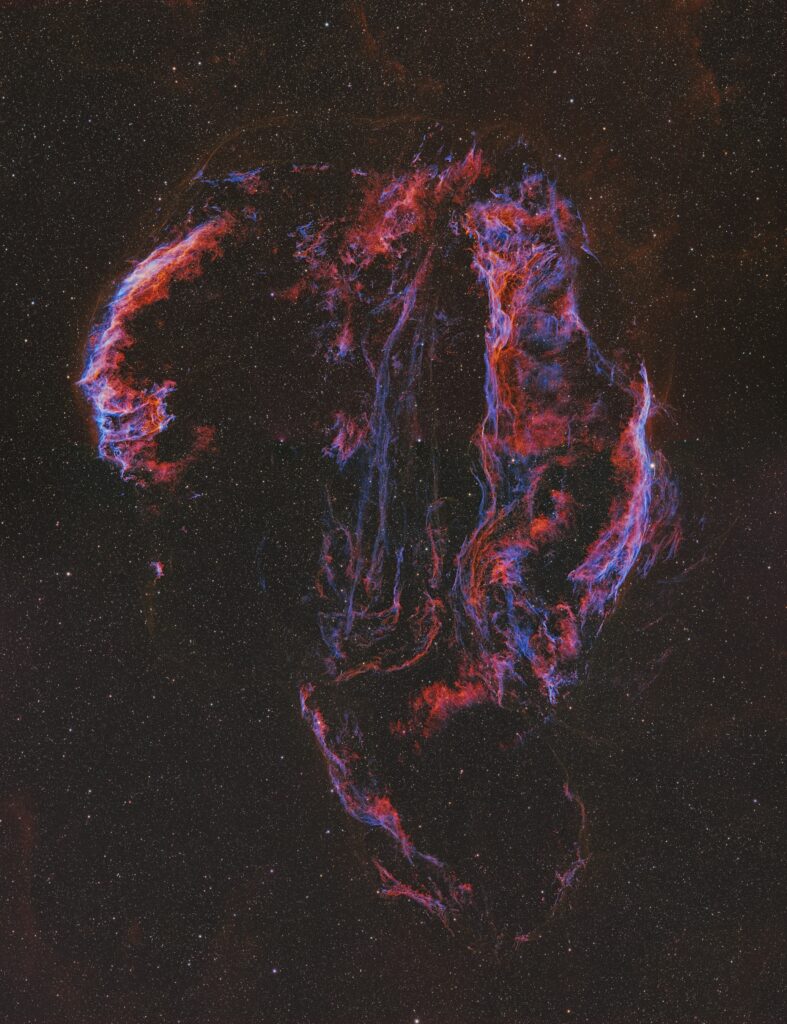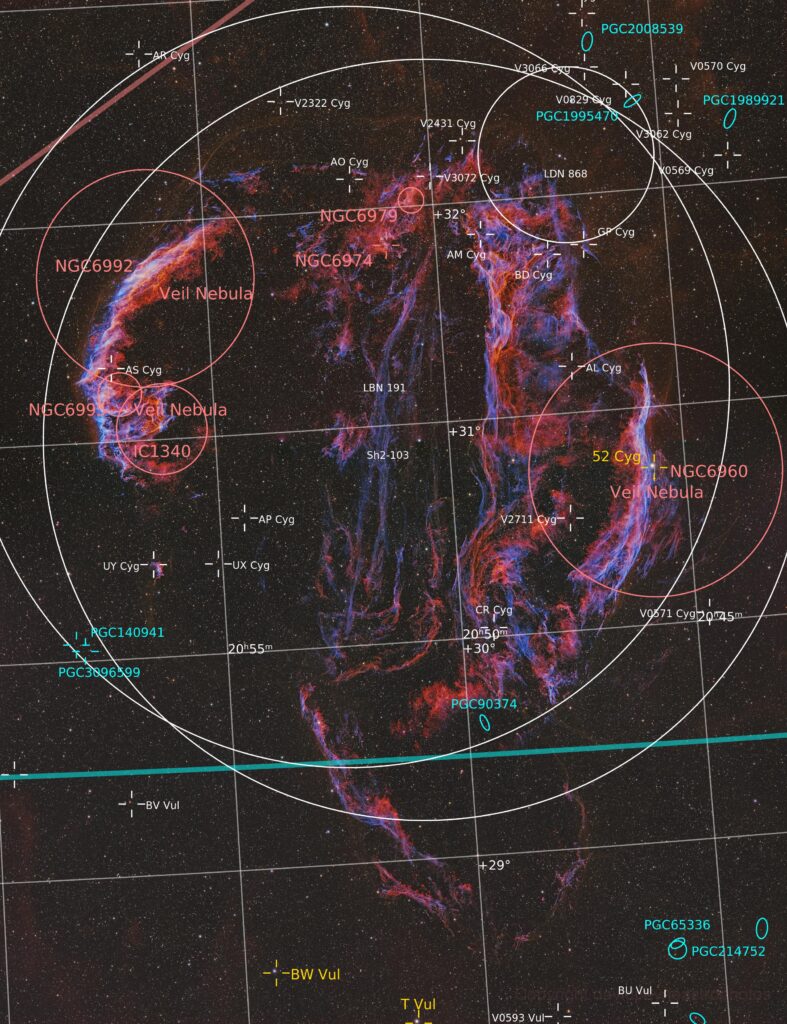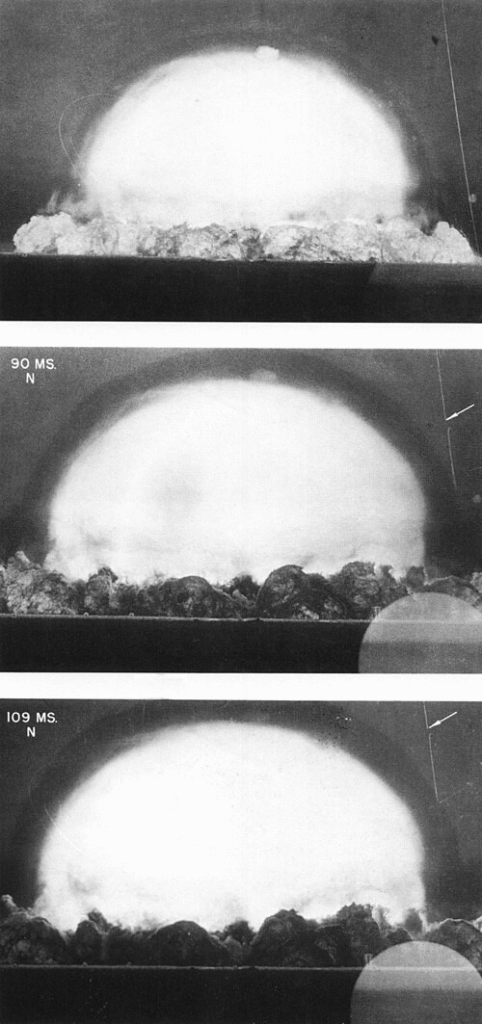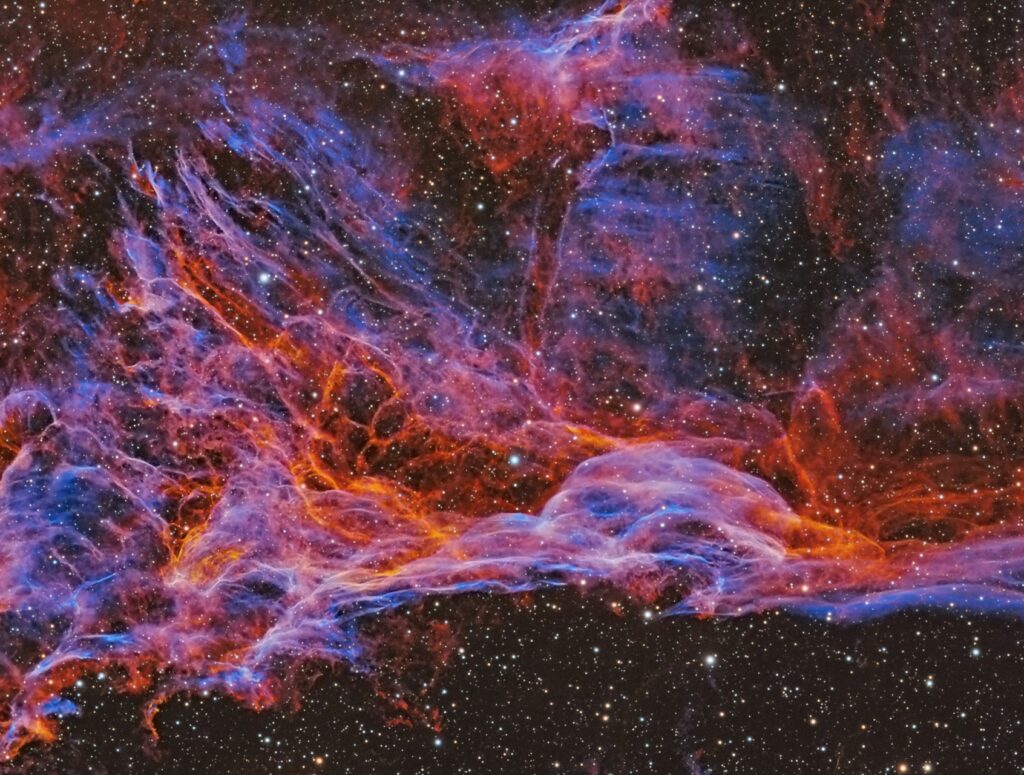The Cygnus Loop is a large spheroidal supernova remnant. What we are really looking at is material either blown out from the supernova star or gathered up by the shock fronts moving out from the explosion. If large enough, a star will undergo a supernova explosion when it is running out of fusing fuel and can no longer sustain its volume against gravity. While the core of a dying star implodes, the sudden release of energy causes a lot of the star to explode violently with both material and light.
This supernova was astronomically fairly close to us at just 1500 light years away, and occurred between 5000 to 8000 years ago. At the time, the starry explosion would have been the brightest object in the Milky Way galaxy sending material away at many times the speed of light. What’s left of the star itself is likely somewhere near the middle of the remnants that we see in the image, but now exists either as a neutron star or a black hole, with its exact current location unknown.
The supernova explosion itself would have been visible to the naked eye just a civilizations were beginning to appear on earth. Being closer and younger than many other supernova remnants in the sky, it is quite bright for the camera but it takes long exposures to bring out its features.


The supernova explosion itself would have been visible to the naked eye just a civilizations were beginning to appear on earth. Such brightness does not last long, however, with brightness peaking and starting to fade generally within hours.
The light show that was the Cygnus Loop supernova has long faded, but the material thrown out of the explosion is still visible and can be captured through the long exposure magic of our cameras.
The whole Cygnus loop takes up about 50x the area of sky than our moon. Even with the short focal length of the telescope used for this image, capturing the whole thing required a mosaic of two full frame images.
Cygnus Loop (Supernova Remnant (SNR)) in SHOAskar FRA500; iOptron HEM27; ASI6200MM, – Antlia Pro 3.5nm Narrowband Filters
2×1 Mosaic: H,O,S : (73,68,55 x 780s Bin 1, Gain 100) Total integration time = 42.5 hrs (July 9 to 17, 2024) Maple Bay, BC
For full resolution, downloadable image, link to Victoria RASC Zenfolio or Astrobin.
The explosive blast does is creates a spherical inflating balloon-like bubble, with the actual balloon surface made up of both material originating from the supernova star and additional material swept up at the front as the balloon expands. Atoms from the explosion are thrown out at supersonic velocity – faster than pressure wave – and with great momentum. Any other atoms in the interstellar medium have no warning, not even a pressure hint that a wall of material is coming their way and they truly must be shocked when it arrived. They are very simply swept up at the front as arriving material shares its energy and momentum and only slightly reducing its velocity as the front expands outward. The front moves like a bulldozer, accumulating material as it moves, right at its blade. This wall of material is known as a shock front partly because the density of material at any given point in its path takes a step change upward when it arrives. There is little dispersion at the front because it travels faster than pressure can diffuse or pressure waves can travel and is therefore supersonic. The supersonic shock front captures nearly everything it encounters, and leaves a strong vacuum (absence of material) in its wake.
The explosive blast does is creates a spherical inflating balloon-like bubble, with the actual balloon surface made up of both material originating from the supernova star and additional material swept up at the front as the balloon expands. Atoms from the explosion are thrown out at supersonic velocity – faster than pressure wave – and with great momentum. Any other atoms in the interstellar medium have no warning, not even a pressure hint that a wall of material is coming their way and they truly must be shocked when it arrived. They are very simply swept up at the front as arriving material shares its energy and momentum and only slightly reducing its velocity as the front expands outward. The front moves like a bulldozer, accumulating material as it moves, right at its blade. This wall of material is known as a shock front partly because the density of material at any given point in its path takes a step change upward when it arrives. There is little dispersion at the front because it travels faster than pressure can diffuse or pressure waves can travel and is therefore supersonic. The supersonic shock front captures nearly everything it encounters, and leaves a strong vacuum (absence of material) in its wake.
In our image, the shock front positions are indicated by what appears to be tendrils of material which are actually shock front planes, that appear two dimensional due to the brightness variation generated by the relative angle of the shock front plane to the camera.

In the picture at left (I believe was taken from the original Trinity atomic testing), a dark shadow can be seen around the explosive fireball. The supersonic shock front is travelling into stationary air increasing its density and refractive index that we see as a shadow. The study of supersonic flows of fluids is a large field of study in itself, but is more often combined with flow past solid bodies. In any event, we sometimes use that fact that we often make chokes (or small orifices) to limit the fluid flow rates (particularly gases) to the subsonic rates that pressure differentials can generate. It is obviously, very useful in the study of ballistics or supersonic air travel.
You may be wondering why the Cygnus Loop doesn’t appear as a shadow – instead it actually emits light that is captured by the camera. The reason is that all that friction between material at the shock front heats the atoms and molecules to a very high temperature – 2.9 Million degrees C. Many of the atoms are of ions, and most are in quantum stimulated energy states. As their electrons transition, they emit the same spectral lines that we are used to imaging in other nebula. Particularly strong are the red hydrogen alpha line and the blue/green line of ionized oxygen..
You may also be wondering why the Cygnus Loop also doesn’t appear spherical. The answer to this required a considerable amount of staring on my part and trying to visualize the perspective. At right I have taken an older image of mine, and drawn where I see the outer limit of the shock wave effects. Overall, the shock wave appears spherical, except for a large growth at the bottom. As for the highly visible material, it looks as if two “ends” of a sphere have been blown off, leaving a donut shaped strip in the middle. Ok, so it is kind of spherical but there must be something else going on here.
Another thing to note, is that why are there tendrils of material representing multiple shock front planes, and not one shock front as in our atomic detonation? Finally, a last question involves the colour of the tendrils that define something about the composition and properties of the tendrils themselves. In our simple model of a single mass of material sweeping outward, why would the tendrils be different in composition and mass.
The answer has a little to do something to do with both the nature of the supernova itself. A supernova is actually an implosion of its innercore to a neutron star or possibly a black hole, realising a huge amount of energy both thermal and electromagnetic. A portion of the outer part of the star is imparted with enormous temperature, pressure and outward momentum that it simultaneously explodes. (Part of this energy and there is a lot to go around is used to nuclear fuse this material into elements heavier than the exothermic iron atom, but this is for another posting). A lot of the particles momentum is achieved through sudden, subsonic expansion within the star, but the what is subsonic within the star is going to be super sonic once the particles leave the star and enter the interstellar medium, with a lot lower speed of sound. The intense electromagnetic (light) radiation undoubtedly imparts a lot of “light pressure” on these particles, further increasing their speed and momentum. However, the explosive speed of the particles will depend upon their mass yields possible multiple waves of supersonic fronts and even these waves may not be perfectly spherical in origin.
Of More of importance is likely the density and nature of the ISM medium the these supersonic particles. Although in reality what we have is a particle leaving the star and entering a rarefied sea of relatively stationary other particles. Nonetheless, I think is useful to think of the supersonics particles like a supersonic jet travelling through air. You will note the jet plane at right, that represents our particle moving supersonically, generates a conical shock wave in the medium of air it is travelling through. As it turns out, the shape of the shock wave (the angle formed to the leading edges of the plane itself) is dependent on the speed of the plane, but also the density and other properties (including sonic velocity) of the material it is travelling through. The density and composition of the ISM that our supersonic particles travels through will not at all be homogeneous, so it is not a stretch of the imagination that the tendrils form as sort of conics in the wake of many supersonic particles.

Unlike our jet plane which is provided with thrust as it travels, our supersonic particles only have the momentum they were imparted with at the supernova explosion. Although rarefied, the particles will experience increasing drag as it gathers more and more ISM into its shock wave. Eventually, some of the supersonic particles will slow down and stop, leaving their shock fronts to slowly dissipate under subsonic conditions.
One last complicated factor is that these shock waves are truly density waves and as they travel, they are subject to reflections as well as interference with other shock waves. This all adds to the intricate patterning we see in these supernova remnant images. If you look closely, you will see, outside of the tendrils a vestige of particles that essentially form the initial supersonic shock front and fainter Ha emissions that have left the interstellar tendrils behind. This front is of various intensity and distance out from the centre, depending largely upon the density (and level of drag) they have experienced on their travels. The background of the Cygnus Loop indicates that this supernova actually took place within a molecular cloud – evident in the very weak background emissions further out still. You may not that within the centre of the SNR donut and within its two caps, these emissions are largely absent with the material now supersonically swept to form the tendrils.
We are not sure what causes hook of material at the bottom of the image, but a small neutron star has been found near the centre of the bubble formed by the hook. Could this be the results of a second supernova? Or perhaps during the initial supernova the initial star broke apart? I truly have no idea.
One pattern that has emerged for me as an astrophotographer though, is that whenever I see sharp multiple tendril like fronts, it likely indicates either a supernova remnant or Wolf Rayet star. Particularly the [OIII} or oxygen signal, which usually yeilds diffuse, or at best singular sharp fronts (such as bow fronts), only yeilds shaper multi-tendril patterns when supersonic relative velocities are involved. I consider this very diagnostic.
Finally, one does not have to capture the whole of the Cygnus Loop to use it as a target. There are multiple areas of the Loop that create beautiful “star scapes”. The ones I show here have been cropped from the initial mosaic…






